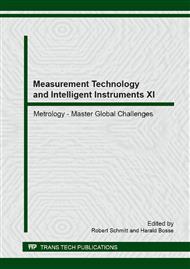[1]
G. Widmann, Image-guided surgery and medical robotics in the cranial area, Int J. Med Robot, 3, 1(2007).
Google Scholar
[2]
R. F. Labadie, R. Balachandran, J. E. Mitchell, J. H. Noble, O. Majdani, D. S. Haynes, M. L. Bennett, B. M. Dawant, and J. M. Fitzpatrick, Clinical validation study of percutaneous cochlear access using patient-customized microstereotactic frames, Otology & Neurology, 31, 1 (2010).
DOI: 10.1097/mao.0b013e3181c2f81a
Google Scholar
[3]
A. Hussong, T. S. Rau, H. Eilers, S. Baron, B. Heimann, M. Leinung, T. Lenarz, and O. Majdani, Conception and design of an automated insertion tool for cochlear implants, EMBC (2008) 5593–5596.
DOI: 10.1109/iembs.2008.4650482
Google Scholar
[4]
I. Stenin, S. Hansen, M. Becker, J. Hirschfeld, B. Bojovic, T. Klenzer, and J. Schipper, MUKNO -Multi-Port-Knochenchirurgie am Beispiel der Otobasis: Virtuelle Planung und Machbarkeitsanalyse multiangulärer Bohrkanäle, CURAC2012@MEDICA, CD, Session V, (2012).
Google Scholar
[5]
M. Feng, Y. Fu, B. Pan, and C. Liu, Development of a medical robot system for minimally invasive surgery, Int J Med Robot Comp, 8 (2012) 85–96.
DOI: 10.1002/rcs.440
Google Scholar
[6]
R. L. Galloway and R. J. Maciunas, Stereotaxic Neurosurgery, Crit Rev Biomed Eng, 18 (1990) 181–205.
Google Scholar
[7]
R. Steinmeier, J. Rachinger, M. Kaus, O. Ganslandt, W. Huk, and R. Fahlbusch, Factors influencing the application accuracy of neuronavigation systems, Stereot Funct Neuros, 75, 4 (2000) 188–202.
DOI: 10.1159/000048404
Google Scholar
[8]
W. Wittmann, T. Wenger, B. Zaminer, and T. C. Lueth, Automatic Correction of Registration Errors in Surgical Navigation Systems, IEEE T Bio-Med Eng, 58, 10 (2011) 2922–2930.
DOI: 10.1109/tbme.2011.2163156
Google Scholar
[9]
R. R. Shamir, L. Joskowicz, and Y. Shoshan, Fiducial Optimization for Minimal Target Registration Error in Image-Guided Neurosurgery, IEEE T Med Imaging, 31 (2012) 725–737.
DOI: 10.1109/tmi.2011.2175939
Google Scholar
[10]
DIN, International vocabulary of metrology (VIM), ISO/IEC-guideline 99 (2010) 3rd ed., Beuth.
Google Scholar
[11]
ISO, 98-3, Guide to the expression of uncertainty measurement (2008).
Google Scholar
[12]
ISO, 22514-1, Statistical methods in process management - Capability and performance - Part 1: General principles and concepts (2009).
Google Scholar
[13]
ISO, 22514-7, Statistical methods in process management - Capability and performance - Part 7: Capability of measurement processes (2010).
Google Scholar
[14]
ISO, 15530-3, Geometrical product specifications (GPS) - Coordinate measuring machines (CMM): Technique for determining the uncertainty of measurement - Part 3: Use of calibrated workpieces or measurement standards (2012).
DOI: 10.3403/30198174
Google Scholar
[15]
Verein deutscher Ingenieure; Verband der Elektrotechnik Elektronik Informationstechnik, 2630 Blatt 1. 4 - Entwurf, Computertomografie in der dimensionellen Messtechnik (2008).
Google Scholar
[16]
R. Schmitt, M. Nau, S. Pollmanns, S. Hansen, and J. Schipper, Bestimmung relevanter Einflussfaktoren auf die Unsicherheit minimalinvasiver Operationen am Beispiel der Otobasis, CURAC2012@MEDICA, CD, Session II (2012) 11-18.
Google Scholar
[17]
R. Gutbell, M. Becker, and S. Wesarg, Ein Prototyp zur Planung von Bohrpfaden für die minimal-invasive Chirurgie an der Otobasis, Bildverarbeitung für die Medizin 2012, Springer (2012) 171–177.
DOI: 10.1007/978-3-642-28502-8_31
Google Scholar
[18]
R. Schmitt, S. Pollmanns, and M. Nau, Accuracy Study of medical CT Systems for Image-Guided Surgery according to VDI/VDE GMA 2630 Guideline, Conference on Industrial Computed Tomography (ICT): Shaker (2012) 209–217.
Google Scholar
[19]
G. Widmann, R. Stoffner, and R. Bale, Errors and error management in image-guided craniomaxillofacial surgery, Oral Surg Oral Med O, 107, 5 (2009) 701–715.
DOI: 10.1016/j.tripleo.2009.02.011
Google Scholar
[20]
ISO, 14253-1, Geometrical product specifications (GPS) - Inspection by measurement of workpieces and measuring equipment - Part 1: Decision rules for proving conformance or non-conformance with specifications (1999).
DOI: 10.3403/01722655u
Google Scholar


